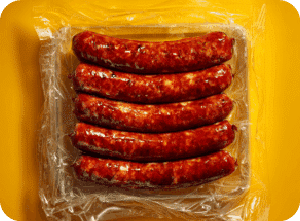When it comes to preserving quality and ensuring food safety, few questions matter more in the meat industry than: how long can cooked sausage stay in the fridge? For consumers, the answer guides safe home storage. But for food manufacturers, distributors, and packaging buyers, it’s a critical issue that affects everything from shelf-life labeling to cold chain logistics and brand trust. A few extra days of freshness can mean the difference between profit and product loss.
In today’s highly regulated and efficiency-driven food landscape, understanding the shelf life of cooked sausage isn’t just a kitchen curiosity—it’s a strategic advantage. This article explores the real science behind sausage spoilage, USDA and FDA guidelines, packaging technologies that extend freshness, and automation tools that reduce contamination risks. We’ll also break down the role of vacuum sealing, modified atmosphere packaging (MAP), and cold chain control in protecting your product from production line to retail shelf.
Whether you’re a CEO evaluating ROI or a plant manager looking to minimize recalls, this guide delivers shelf-life tips that go beyond the basics—grounded in data, aligned with compliance, and built to help your business succeed.
Understanding Shelf Life for Cooked Sausage
What Does “Shelf Life” Really Mean?
“Shelf life” refers to the amount of time a food product remains safe and of acceptable quality. Key definitions:
- Sell-by: For internal retailer use.
- Best-by: Indicates peak quality, not safety.
- Use-by: Often required for safety-critical products.
According to the USDA FSIS and FoodSafety.gov, cooked sausage can be refrigerated at or below 40 °F for up to 1 week, but conservative guidelines recommend 3–4 days to mitigate risk of Listeria monocytogenes.
How Long Can Cooked Sausage Stay in the Fridge?
- Fresh-made sausage links or smoked varieties: 3–4 days in the fridge, 2–3 months in the freezer.
- Hot dogs (sealed and cooked): 1 week once opened, 2 weeks unopened.
Signs of Spoilage
- Discoloration, slimy texture, or sour smell may indicate spoilage.
- However, some pathogens do not alter appearance or odor, so following time and temperature guidelines is critical.
Knowing these timeframes and spoilage cues allows packaging buyers to align food safety with commercial goals.
Key Factors That Impact Sausage Shelf Life
Storage Temperature
Keeping cooked sausage consistently below 40°F (4°C) is the foundation of shelf life. Even brief exposure to warmer temperatures during transport or handling can accelerate spoilage.
Packaging Type
- Vacuum-sealed packaging: Removes oxygen, delaying oxidation and microbial growth.
- MAP (Modified Atmosphere Packaging): Replaces air with CO₂ or N₂ to inhibit spoilage.
- Barrier materials: Protect against moisture loss and oxygen permeability.
Sausage Composition
- Fat content and additives (like nitrites) affect how quickly sausages spoil.
- Cured sausages often last longer than fresh ones due to lower water activity.
Commercial Packaging’s Role in Extending Shelf Life
Cold Chain Compliance
Packaging is only part of the equation—cold chain logistics matter just as much. A temperature spike during shipping can undo even the best packaging effort.
- Smart sensors and data logging devices are increasingly used to track temperature exposure across the supply chain.
Vacuum Sealing and MAP
- A MAP blend of 70% CO₂ and 30% N₂ has been shown to extend cooked sausage shelf life to 28 days at 4 °C [(FRI, 2023)].
- Vacuum sealing extends fridge life to 6–7 days compared to 3–4 without it.
Choosing the right packaging method directly affects shelf life and waste reduction.
Tray Sealing and Thermoforming Options
- Skin packs and thermoformed trays offer durable, tamper-evident formats.
- Custom sealing parameters ensure oxygen levels remain below spoilage thresholds.
Innovations in Shelf-Life Monitoring
Time–Temperature Indicators (TTIs)
These visual tools change color based on accumulated time and temperature exposure. They’re ideal for:
- Retail freshness visibility
- Internal QA tracking
- Recall risk mitigation
Smart Labels and Digital Traceability
- QR codes linked to cold chain data logs
- RFID sensors for bulk batch tracking
- Integration with HACCP documentation
Regulatory Guidelines for Cooked Meat Storage
USDA and FDA Standards
- FDA Food Code: Discard prepared perishable foods after 7 days.
- USDA FSIS: 3–4 days recommended; 1 week is maximum under optimal conditions.
HACCP Considerations
- CCPs (Critical Control Points) include cooking, chilling, and packaging.
- Documentation and traceability are required for USDA/FDA inspections.
Automation’s Impact on Shelf Life and Safety
Minimizing Human Error
- Automated sausage loaders and packers reduce manual handling.
- Better seal integrity and consistent cycle timing = longer shelf life.
Precision Control
- Automated lines can adjust vacuum level, seal time, gas blend, and cooling—more accurately than manual workflows.
Velec Systems’ automated packaging lines integrate seamlessly into chilled sausage operations to help achieve compliance and performance.
Economic Implications of Better Packaging
Reducing Product Waste and Recalls
Extending shelf life by even 1–2 days can drastically reduce retailer shrink and end-user spoilage claims.
Boosting Brand Trust
- A longer, safer shelf life builds consumer confidence.
- Fewer returns and complaints enhance reputation and margins.
Best Practices for Buyers and Plant Managers
Ask Your Packaging Supplier About:
- Gas barrier specifications
- Film oxygen transmission rate (OTR)
- Sealing parameters and leak detection
- Automation support and sanitation certifications
Internal QA Tips
- Date-label audits
- Environmental temperature logging
- Random sampling for spoilage checks
Conclusion: Shelf Life Isn’t Just a Number—It’s a Business Lever
In the meat packaging world, knowing how long cooked sausage can stay in the fridge isn’t just about safety—it’s about staying competitive. A few extra days of viable shelf life—secured through automation, cold chain control, and smart packaging—can reduce waste, prevent recalls, and protect your brand’s reputation.
We’ve covered USDA/FDA guidelines, explored MAP and vacuum sealing, and highlighted automation’s role in extending product life. The bottom line? Shelf life is not fixed. It’s engineered.
📌 Ready to upgrade your sausage packaging strategy?
Contact Velec Systems to learn how our precision-engineered automation and packaging solutions can help you reduce risk, extend shelf life, and improve profitability across your meat packaging operations.
Frequently Asked Questions
❓ How long can cooked sausage stay in the fridge before it spoils?
3–4 days under 40°F. Vacuum-sealed or MAP-packaged sausage may last up to 7 days.
❓ Can vacuum-sealed cooked sausage last longer in the fridge?
Yes. Up to 7 days refrigerated when properly sealed and chilled.
❓ How long does cooked sausage last in the freezer?
1–2 months, assuming it’s wrapped tightly and frozen below 0°F.
❓ What are the signs of spoiled cooked sausage?
Sliminess, discoloration, sour smell. But beware—some pathogens offer no visible signs.
❓ How does MAP extend cooked sausage shelf life?
By replacing oxygen with CO₂ or N₂, MAP slows microbial growth and fat oxidation.
References
- FDA Cold Storage Chart
- USDA FSIS Sausages and Food Safety
- FDA Food Code Summary – State Food Safety
- Iowa State University MAP Study
- Wisconsin FRI MAP Research Brief
- Velec Systems: Maximizing Sausage Shelf Life
- Velec Systems: Sausage Packaging for Temperature Regulation
- Velec Systems: Vacuum vs MAP Packaging






